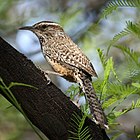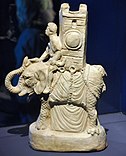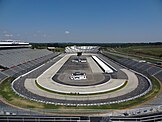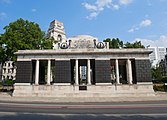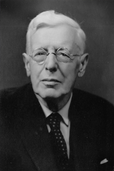Wikipedia:Today's featured article/September 2020
| << | Today's featured articles for September 2020 | >> | ||||
|---|---|---|---|---|---|---|
| Su | Mo | Tu | We | Th | Fr | Sa |
| 1 | 2 | 3 | 4 | 5 | ||
| 6 | 7 | 8 | 9 | 10 | 11 | 12 |
| 13 | 14 | 15 | 16 | 17 | 18 | 19 |
| 20 | 21 | 22 | 23 | 24 | 25 | 26 |
| 27 | 28 | 29 | 30 | |||
September 1

Vespro della Beata Vergine (Vespers for the Blessed Virgin) by Claudio Monteverdi is an extended composition for the evening vespers on Marian feasts, printed in 1610. The composer set the usual Latin psalms and Magnificat, but also solo concertos in the style of the emerging opera. The ambitious composition, which uses traditional Gregorian chant as cantus firmus, is scored for soloists, choirs of up to ten parts, and orchestra. Monteverdi wrote it when he was maestro di capella in Mantua, where he served as musician and composer for the Gonzagas, the Dukes of Mantua. He had it printed in Venice, with a dedication to Pope Paul V dated 1 September 1610 (pages from a copy pictured). He then travelled to Rome to deliver it to Pope Paul in person. Monteverdi became director of music at San Marco in Venice in 1613. His Vespers represent a milestone of music history at the transition from Renaissance to Baroque styles. (Full article...)
September 2

The Third Silesian War was a conflict between Prussia and an Austrian alliance that lasted from 1756 to 1763 and confirmed Prussia's control of Silesia (now in south-western Poland). The war was fought mainly in Silesia, Bohemia and Upper Saxony and formed one theatre of the Seven Years' War. It can be viewed as a continuation of the First and Second Silesian Wars of the previous decade. The war was costly on both sides and ended inconclusively when neither of the main belligerents could sustain the conflict any longer. The war began with a Prussian invasion of Saxony in mid-1756, and it ended in a Prussian diplomatic victory with the 1763 Treaty of Hubertusburg. The conflict formed part of the ongoing Austria–Prussia rivalry that would shape German politics for more than a century. The war enhanced the prestige of Prussia, which was recognised as a major European power, and of Frederick, who cemented his reputation as a preeminent military commander. (This article is part of a featured topic: Silesian Wars.)
September 3
The cactus wren (Campylorhynchus brunneicapillus) is a large wren that is endemic to the deserts of the United States and Mexico. It is the state bird of Arizona. The wren's upperparts are brown with black and white spots and the underparts are cinnamon-buff with a whiter breast; it has striking white eyebrows. The song is loud and raspy. Cactus wrens are ground feeders and eat mainly insects, with some plant material; they can meet their water needs from their diet. The wrens use saguaro and cholla cacti as nesting sites, which provide protection for their large bulky nests and their young. The wrens are non-migratory and territorial around their nests. Pairs are monogamous; males build nests, females incubate eggs, and both parents feed chicks. Populations have declined due to human activities, habitat loss and introduced species including cats, but the wrens still number in the millions. The species is classed as being of least concern by the International Union for Conservation of Nature. (Full article...)
September 4
Ismail I (1279–1325) was the fifth Nasrid ruler of the Emirate of Granada (map pictured) on the Iberian Peninsula, from 1314 to 1325. He claimed the throne during the reign of his uncle, Sultan Nasr, after a rebellion started by his father Abu Said Faraj. Ismail was proclaimed sultan in February 1314. He spent the early years of his reign fighting Nasr, who attempted to regain the throne after enlisting the help of Castile. The war reached its climax in the Battle of the Vega in 1319, a complete victory for Ismail's forces over Castile. The deaths in the battle of Infante Peter and Infante John, the two regents for the infant King Alfonso XI, left Castile leaderless. Ismail followed up his victory with the capture of castles on the Castilian border in 1324 and 1325. He was murdered by his relative Muhammad ibn Ismail. Historians characterise Ismail as an effective ruler who improved the emirate's position with military victories. (Full article...)
September 5
The Battle of the Bagradas River was a victory by a Carthaginian army led by Xanthippus over a Roman army led by Marcus Atilius Regulus in early 255 BC, nine years into the First Punic War. The previous year Roman forces had advanced on the city of Carthage in North Africa and defeated the Carthaginian army at the Battle of Adys. In despair, the Carthaginians sued for peace, but the proposed terms were so harsh they decided to fight on. They gave charge of their army to the Spartan mercenary general Xanthippus, who led 12,000 infantry, 4,000 cavalry and 100 war elephants (statuette pictured) against the Romans' 15,000 infantry and 500 cavalry. The Romans had no effective answer to the elephants, their outnumbered cavalry were chased from the field, and most of their infantry were surrounded and wiped out. The Romans subsequently evacuated Africa. The war ended in 241 BC with a Roman victory; the terms agreed were more generous than those proposed 14 years earlier. (Full article...)
September 6
The Tweed Courthouse (officially the Old New York County Courthouse) is a historic courthouse building in Civic Center, Manhattan, New York City. Listed on the U.S. National Register of Historic Places and protected as a New York City designated landmark, it is the second-oldest city-government building in Manhattan, after City Hall. It was built in the Italianate style, with Romanesque Revival interiors, under the leadership of William M. "Boss" Tweed, whose political machine, Tammany Hall, controlled the city and state governments when the courthouse was built. Architect John Kellum designed the original two wings of the building, which was constructed from 1861 to 1872. The project was completed by architect Leopold Eidlitz, who added the rear wing and finished the interior between 1877 and 1881. Modern restoration and historic preservation were completed in 2001. (Full article...)
September 7
The flora of Madagascar consists of more than 12,000 species of vascular and non-vascular plants. Around 83 per cent of Madagascar's vascular plants are found only on the island. These include five entirely endemic plant families as well as most of the over 900 orchid species, the traveller's tree, the Madagascar periwinkle, six species of baobab (pictured) and around 200 species of palms. The high degree of endemism is due to Madagascar's long isolation following its separation from the African and Indian landmasses in the Mesozoic Era. Today, humid forests, including the lowland forests, are found on the eastern plateau. Much of the central highlands is grassland. In the west are dry forest and succulent woodland. Unique spiny thickets are in the southwest, and mangroves occur on the west coast. While 10 per cent of the land surface is protected, much of the native flora is threatened, especially through dramatic deforestation. (Full article...)
September 8
The Bread-Winners is an 1883 anti-labor novel by John Hay, who was Assistant Secretary to the President under Abraham Lincoln, and McKinley's final secretary of state. Originally published anonymously in installments in The Century Magazine, the book attracted wide interest and provoked considerable speculation over the author's identity. Hay wrote his only novel as a reaction to several strikes that affected him and his business interests in the 1870s and early 1880s. In the main storyline, a wealthy former army captain, Arthur Farnham, organizes Civil War veterans to keep the peace when the Bread-winners, a group of lazy and malcontented workers, call a violent general strike. Hay left hints as to his identity in the novel, and some guessed right, but he never acknowledged the book as his, and it did not appear with his name on it until after his death in 1905. Hay's hostile view of organized labor was soon seen as outdated, and the book is best remembered for its onetime popularity and controversial nature. (Full article...)
September 9
Michelle Williams (born September 9, 1980) is an American actress. Her accolades include two Golden Globe Awards, and she has been nominated for four Academy Awards and one Tony Award. She made her feature film debut in Lassie (1994), and starred in the television teen drama series Dawson's Creek (1998–2003). She earned her first Academy Award nomination playing the wife of a gay man in Brokeback Mountain (2005). Williams played troubled characters in the independent dramas Wendy and Lucy (2008), Blue Valentine (2010), and Manchester by the Sea (2016). For portraying Marilyn Monroe in My Week with Marilyn (2011) and Gwen Verdon in Fosse/Verdon, she won two Golden Globe Awards. Her highest-grossing releases came with the thriller Shutter Island (2010), the fantasy film Oz the Great and Powerful (2013), the musical The Greatest Showman (2017), and the superhero film Venom (2018). She was nominated for the Tony Award for Best Actress in a Play for the role of a sexually abused woman in Blackbird. (Full article...)
September 10
Hurricane Gordon was the third hurricane and first major hurricane of the 2006 Atlantic hurricane season. It was the first tropical cyclone since 1992 to affect the Azores while retaining tropical characteristics. Gordon formed on September 10 in the tropical Atlantic Ocean. It gradually matured into a hurricane as it tracked northward, reaching its peak intensity with winds of 195 km/h (121 mph) early on September 14 while located about 925 km (575 mi) southeast of Bermuda. It weakened after moving over cooler waters, and passed through the Azores on September 20. Wind gusts reached hurricane force on Santa Maria Island, but the Azores sustained little damage. Gordon then became an extratropical cyclone and affected Spain, Ireland, and the United Kingdom. In Spain, wind gusts reached 183 km/h (114 mph) along the northwest coast, left 100,000 people without power, and injured five people. In Northern Ireland, high winds left 120,000 people without power and caused one injury. (Full article...)
September 11
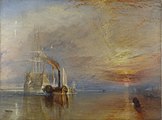
by J. M. W. Turner
HMS Temeraire was a 98-gun ship of the line of the British Navy, serving in the French Revolutionary and Napoleonic Wars. Built at Chatham Dockyard, Temeraire was launched in 1798 and commissioned in 1799. After years of routine duties she joined Horatio Nelson's fleet in 1805. At the Battle of Trafalgar she was just astern of Nelson's flagship, HMS Victory. During the battle Temeraire came to Victory's rescue, and fought and captured two French ships, winning public renown in Britain. She served routinely until 1813 when she was laid up. She later acted as a prison ship, a receiving ship, a victualling depot, and a guard ship. She was sold in 1838 and towed up the Thames to be broken up. Her last voyage is depicted in a J. M. W. Turner oil painting (pictured), which was greeted with critical acclaim. The painting was voted Britain's favourite painting in a 2005 BBC Radio 4 poll, and a reproduction appears on the 2020 Bank of England £20 note. (Full article...)
September 12
The qibla is the direction towards the Kaaba in the Sacred Mosque, Mecca, Saudi Arabia, which is used by Muslims in various religious contexts, including ritual prayer. Muslims believe the Kaaba to be a sacred site built by the prophets Abraham and Ishmael, and that its use was ordained by God in several verses of the Quran revealed in the second Hijri year. Prior to this revelation, Muhammad and his followers in Medina faced Jerusalem for prayers. Most mosques contain a mihrab or a wall niche that indicates the direction of the qibla. Before the development of astronomy in the Islamic world, Muslims used traditional methods to determine the qibla. These methods included facing the direction that the companions of Muhammad had used when in the same place or using the setting and rising points of celestial objects. In the late 9th and 10th centuries, Muslim astronomers developed methods to find the exact direction of the qibla, and today it can be calculated using a trigonometric formula. (Full article...)
September 13
Super Mario All-Stars is a 1993 compilation of platform games for the Super Nintendo Entertainment System. It contains remakes of Nintendo's four Super Mario titles released for the Nintendo Entertainment System and its Family Computer Disk System add-on: Super Mario Bros. (1985), Super Mario Bros.: The Lost Levels (1986), Super Mario Bros. 2 (1988), and Super Mario Bros. 3 (1988). They are faithful recreations that adapt the games' original premises and level designs with updated graphics and music. Parallax scrolling was added, physics simulations were modified, and some glitches were fixed. Mario creator Shigeru Miyamoto (pictured) suggested that Nintendo develop the compilation. It received critical acclaim and is one of the bestselling Super Mario titles, with 10.55 million copies sold by 2015. Reviewers praised the effort that went into remastering the compilation's games and appreciated the updated graphics and music, but criticized its lack of innovation. (Full article...)
September 14

US Highway 141 is a north–south United States Numbered Highway that runs for about 169 miles (272 km) in the states of Wisconsin and Michigan. The highway runs north-northwesterly from Bellevue, Wisconsin, near Green Bay, to an intersection near Covington, Michigan. In between, it follows city streets in Green Bay and a freeway section north of that city. Most of the remainder of US 141 is a rural two-lane highway that crosses into Michigan, back into Wisconsin and then finally back into Michigan again. When the highway was created in 1926, its northernmost section in Michigan was numbered US 102, and US 141 extended farther south from Bellevue to Milwaukee. Two years later, US 141 was extended north into Michigan to replace US 102. Since then, parts of the highway have been converted to freeway; the highway has ended southeast of Green Bay in Bellevue since the 1980s—the southern segment was redesignated as I-43. (This article is part of a featured topic: U.S. Highways in Michigan.)
September 15
The 2006 Subway 500 was the 32nd stock car race of the 2006 NASCAR Nextel Cup Series and the sixth in the ten-race Chase for the Nextel Cup. It was held on October 22, 2006, before a crowd of 65,000, at Martinsville Speedway (pictured) in Martinsville, Virginia, one of five short tracks to hold NASCAR races. The 500-lap race was won by Jimmie Johnson of Hendrick Motorsports; Denny Hamlin finished second, and Bobby Labonte came in third. Kurt Busch won the pole position with the fastest time in qualifying; Johnson started from ninth position. There were 18 cautions and 16 lead changes by five different drivers during the race. Johnson's win was his fifth of the 2006 season, and the 23rd of his career. The result advanced him to third in the Drivers' Championship, 41 points behind Matt Kenseth, who took over the championship lead after Jeff Burton retired from the race. Chevrolet maintained its lead in the Manufacturers' Championship with four races left in the season. (Full article...)
September 16
"Style" is a song recorded by American singer-songwriter Taylor Swift (pictured) for her fifth studio album, 1989 (2014). It was written and produced by Max Martin, Shellback, and Ali Payami, with additional writing by Swift, and released to US radio stations as the album's third single. Musically, "Style" incorporates disco, funk, and pop rock. The song garnered generally positive reviews from critics, many of whom deemed it the album's highlight. It earned an APRA Music Award nomination for International Work of the Year and appeared on year-end lists of Pitchfork and The Village Voice. "Style" peaked at number six on the Billboard Hot 100 in the US, becoming 1989's third consecutive Hot 100 top-ten single, and received multi-platinum certifications in Australia and Canada. Swift included "Style" on regular set lists for two of her world tours: The 1989 World Tour (2015) and the Reputation Stadium Tour (2018). (Full article...)
September 17
Infinity Science Fiction was an American science fiction magazine, edited by Larry T. Shaw and published by Royal Publications. The first issue (cover pictured) was on newsstands in September 1955, with a November cover date. Among the short stories in the first issue was Arthur C. Clarke's "The Star", about a planet destroyed by a supernova seen from Earth as the Star of Bethlehem; it won the 1956 Hugo Award for Best Short Story. Harlan Ellison's "Glowworm" appeared in the second issue. Shaw obtained stories from some of the leading writers of the day, including Brian Aldiss, Isaac Asimov, and Robert Sheckley, but the material was of variable quality. In 1958 the owner of Royal Publications, Irwin Stein, decided to shut down Infinity; the last issue was dated November 1958. The title was revived a decade later by Stein's publishing house, Lancer Books, as a paperback anthology series. Five volumes were published between 1970 and 1973, edited by Robert Hoskins. (Full article...)
September 18
Opisthocoelicaudia is a genus of sauropod dinosaur of the Late Cretaceous discovered in the Nemegt Formation in the Gobi Desert of Mongolia. Named and described by Polish paleontologist Maria Magdalena Borsuk-Białynicka in 1977, the type species is Opisthocoelicaudia skarzynskii. A well-preserved skeleton lacking only the head and neck was unearthed in 1965 by Polish and Mongolian scientists, making Opisthocoelicaudia one of the best known sauropods from the Late Cretaceous. Tooth marks on this skeleton indicate that large carnivorous dinosaurs had fed on the carcass. Two more specimens have been found, including part of a shoulder and a fragmentary tail. A relatively small sauropod, Opisthocoelicaudia measured about 11.4–13 metres (37–43 ft) in length. Like other sauropods, it would have been characterised by a small head sitting on a very long neck and a barrel-shaped trunk carried by four column-like legs. It may have been able to rear on its hind legs. (Full article...)
September 19
Alfred Worden (1932–2020) was an American test pilot and astronaut who in 1971 was the command module pilot of the Apollo 15 lunar mission. He graduated from the United States Military Academy in 1955, and was commissioned in the Air Force. He proved adept at flying fighter planes, becoming a test pilot prior to his selection as an astronaut in 1966. Worden served on the support and backup crews for Apollo 9 and 12 before selection for Apollo 15. He spent three days alone in lunar orbit, becoming the person who was the furthest from any other human being, a record he still holds, and also performed the first deep-space extravehicular activity, or spacewalk. His astronaut career was effectively ended by a scandal over carrying postal covers to the Moon, and he retired from NASA in 1975. The author of three books, he subsequently entered the private sector, unsuccessfully ran for Congress, undertook charitable works and promoted a renewed space program. (Full article...)
September 20
Virgin and Child with Canon van der Paele is a large oil-on-oak panel painting completed around 1434–1436 by the Early Netherlandish painter Jan van Eyck. It shows the painting's donor, Joris van der Paele, within an apparition of saints. Van der Paele was then elderly and gravely ill, and intended the work as his memorial. The Virgin Mary is enthroned at the centre of the semicircular space, which likely represents a church interior, with the Christ Child on her lap. Saint Donatian stands to her right, Saint George to her left. The saints are identifiable from Latin inscriptions lining the borders of the imitation bronze frame. The Virgin's throne is decorated with carved representations of Adam and Eve, prefigurations of the Crucifixion and Resurrection of Jesus, and scenes from the Old Testament. The panel is considered one of van Eyck's most fully realised and ambitious works, and has been described as a "masterpiece of masterpieces". (Full article...)
September 21
Bats, of the order Chiroptera, are the only mammals capable of sustained flight. Their wings, spread-out fingers covered by a thin membrane, make them more manoeuvrable than birds. Bats range in size from Kitti's hog-nosed bat, weighing 2–2.6 g (0.07–0.09 oz), to the giant golden-crowned flying fox, up to 1.6 kg (4 lb) with a wingspan of up to 1.7 m (5 ft 7 in). The second largest order of mammals after rodents, bats comprise about 20% of all mammal species, with over 1,200 species distributed across the world. Most bats are nocturnal. They are mostly insect- or fruit-eaters, but some are carnivorous, such as vampire bats. Some are important for pollinating flowers and dispersing seeds; others consume insect pests, reducing the need for pesticides. Bats harbour the agents of many communicable diseases, such as rabies and coronaviruses. They are often associated with darkness, malevolence, vampires, and death. (Full article...)
September 22
Jomo Kenyatta (c. 1897 – 1978) was an anti-colonial activist and politician who governed Kenya as its prime minister from 1963 to 1964 and then as its first president from 1964 to his death in 1978. He was the country's first indigenous head of government and played a significant role in the transformation of Kenya from a colony of the British Empire into an independent republic. In 1947, he began lobbying for independence from British colonial rule through the Kenya African Union, attracting widespread indigenous support. In 1952, he was among the Kapenguria Six arrested and charged with masterminding the anti-colonial Mau Mau Uprising. Although protesting his innocence—a view shared by later historians—he was convicted. Upon his release in 1961, he led the Kenya African National Union party until his death. During his presidency, he secured support from both the black majority and white minority with his message of reconciliation. (Full article...)
September 23
Ealdred (died 1069) was Abbot of Tavistock, Bishop of Worcester, and Archbishop of York in Anglo-Saxon England. After becoming a monk at the monastery at Winchester, he became abbot around 1027 and a bishop in 1047. Besides his clerical duties, Ealdred served Edward the Confessor as a diplomat in Hungary and as a military leader in Wales. In 1058, he undertook a pilgrimage to Jerusalem, the first bishop from England to do so. In 1060, Ealdred was elected to the archbishopric of York. During his archiepiscopate, he built and embellished churches in his diocese, and worked to improve his clergy by promulgating regulations for the priesthood. Following King Edward's death in 1066, Ealdred supported Harold as king, but when Harold was defeated at the Battle of Hastings, Ealdred eventually endorsed William the Conqueror and crowned him on Christmas Day in 1066. William never quite trusted Ealdred, and Ealdred had to accompany William back to Normandy in 1067, but he had returned to York by the time of his death in 1069. (Full article...)
September 24
Erin Phillips (born 1985) is an Australian rules footballer for the Adelaide Football Club in the AFL Women's (AFLW) competition and a former professional basketball player. With the launch of the AFLW in 2017, Phillips began her football career at age 31. Despite not having played competitive football since she was 13 years old, Phillips won the AFLW best and fairest award by a wide margin twice in her first three seasons in 2017 and 2019. In both years, she also led Adelaide to the premiership and won best on ground in the AFLW Grand Final. Before her football career, Phillips played nine seasons in the Women's National Basketball Association (WNBA), winning her first WNBA title with the Indiana Fever in 2012 and another with the Phoenix Mercury in 2014. She also represented Australia on the women's national basketball team, winning a gold medal at the 2006 FIBA World Championship for Women and serving as a co-vice captain at the 2016 Summer Olympics. (Full article...)
September 25
The Tower Hill Memorial is a pair of Commonwealth War Graves Commission memorials in Trinity Square, on Tower Hill in London, England. The memorials, one for the First World War and one for the Second, commemorate more than 36,000 men and women of the Merchant Navy and fishing fleets who were killed as a result of enemy action and have no known grave. The dead are named on bronze panels ordered by the ships they served on. The first memorial, the Mercantile Marine War Memorial (pictured), was commissioned following the heavy losses sustained by merchant shipping in the First World War. It was designed by Sir Edwin Lutyens and unveiled by Queen Mary in 1928. The second, the Merchant Seamen's Memorial, is a semi-circular sunken garden designed by Sir Edward Maufe and unveiled by Queen Elizabeth II in November 1955. A third memorial, commemorating merchant sailors who were killed in the 1982 Falklands War, was added to the site in 2005. The memorials to the world wars are listed buildings. (Full article...)
September 26
Banksia blechnifolia is a species of flowering plant that was first described by Victorian state botanist Ferdinand von Mueller in 1864. Its leaves are reminiscent of the fern genus Blechnum. B. blechnifolia is one of several closely related species that grow as prostrate shrubs, with horizontal stems and thick, leathery upright leaves. The red-brown flower spikes are up to 20 centimetres (8 in) high and appear from September to November. As the spikes age, they turn grey and develop as many as 25 woody seed pods. Insects such as bees, wasps, ants and flies pollinate the flowers. Found in sandy soils in the south coastal region of Western Australia in the vicinity of Lake King, B. blechnifolia is non-lignotuberous, regenerating by seed after bushfire. The plant adapts readily to cultivation, growing in well-drained sandy soils in sunny locations. It is suitable for rockeries and as a groundcover. (Full article...)
September 27
Margaret Macpherson Grant (1834–1877) was a Scottish heiress and philanthropist. Born in Aberlour parish to a local surgeon, she was educated in Hampshire and inherited a large fortune from her uncle, Alexander Grant, a planter and merchant who had become rich in Jamaica. Macpherson Grant took up residence in Aberlour House, which had been built for her uncle by William Robertson. She lived unconventionally for a woman of her time, entering into what was described as a form of marriage with a female companion, Charlotte Temple, whom she met in London in 1864. Macpherson Grant donated generously to charitable enterprises, establishing an orphanage (now the Aberlour Child Care Trust) and founding St Margaret's Episcopal Church in Aberlour. She made several wills over the course of her life that would have left her estate to Temple, but after Temple left her to marry a man, Macpherson Grant revoked her will, and the bulk of her fortune went to cousins, who were probably unknown to her. (Full article...)
September 28
Rigel is a blue supergiant star in the constellation of Orion, approximately 860 light-years (260 pc) from Earth. It is the brightest and most massive component of a star system of at least four stars that appear as a single blue-white point of light to the naked eye. A star of spectral type B8Ia, Rigel is calculated to be anywhere from 61,500 to 363,000 times as luminous as the Sun, and 18 to 24 times as massive. Its radius is over 70 times that of the Sun, and its surface temperature is 12,100 K. Rigel varies slightly in brightness, its apparent magnitude ranging from 0.05 to 0.18. It is classified as an Alpha Cygni variable. It is generally the seventh-brightest star in the night sky and is usually the brightest star in Orion, though it is occasionally outshone by Betelgeuse. With an estimated age of 7 to 9 million years, Rigel has exhausted its core hydrogen fuel, expanded and cooled to become a supergiant. It will end its life as a type II supernova. (Full article...)
September 29
Valston Hancock (31 May 1907 – 29 September 1998) was a senior commander in the Royal Australian Air Force (RAAF). A graduate of the Royal Military College, Duntroon, Hancock transferred to the RAAF in 1929 and qualified as a pilot. After fifteen years of occupying staff and training posts, he saw combat in the Aitape–Wewak campaign of the Pacific War during 1945. Flying Bristol Beaufort light bombers, he led No. 100 Squadron, and later No. 71 Wing, earning the Distinguished Flying Cross. After the war, Hancock became the inaugural commandant of RAAF College, followed by a succession of senior positions, before being promoted to air marshal and serving as Chief of the Air Staff from 1961 to 1965. He was knighted in 1962. In his role as the Air Force's senior officer, Hancock continued the policy of developing a chain of forward airfields in Northern Australia. He also evaluated potential replacements for the RAAF's English Electric Canberra bomber. (Full article...)
September 30
Herbert Maryon (1874–1965) was an English sculptor, conservator, goldsmith, archaeologist and authority on ancient metalwork. Maryon was the first director of the Arts and Crafts–inspired Keswick School of Industrial Art, then taught at the universities of Reading and Durham until 1939. During this time he designed the University of Reading War Memorial, excavated one of the oldest gold artefacts in Britain, and authored the standard Metalwork and Enamelling. Maryon left retirement to join the British Museum, and is best known for his conservation work on the Sutton Hoo ship-burial, including restorations of the shield, the drinking horns, and the iconic Sutton Hoo helmet. In other work he restored a Roman helmet, coined the term pattern welding, and wrote a paper influencing a painting by Salvador Dalí. Maryon was appointed to the Order of the British Empire in 1956; asked by Queen Elizabeth II what he did, Maryon responded: "Well, Ma'am, I am a sort of back room boy at the British Museum." (Full article...)
